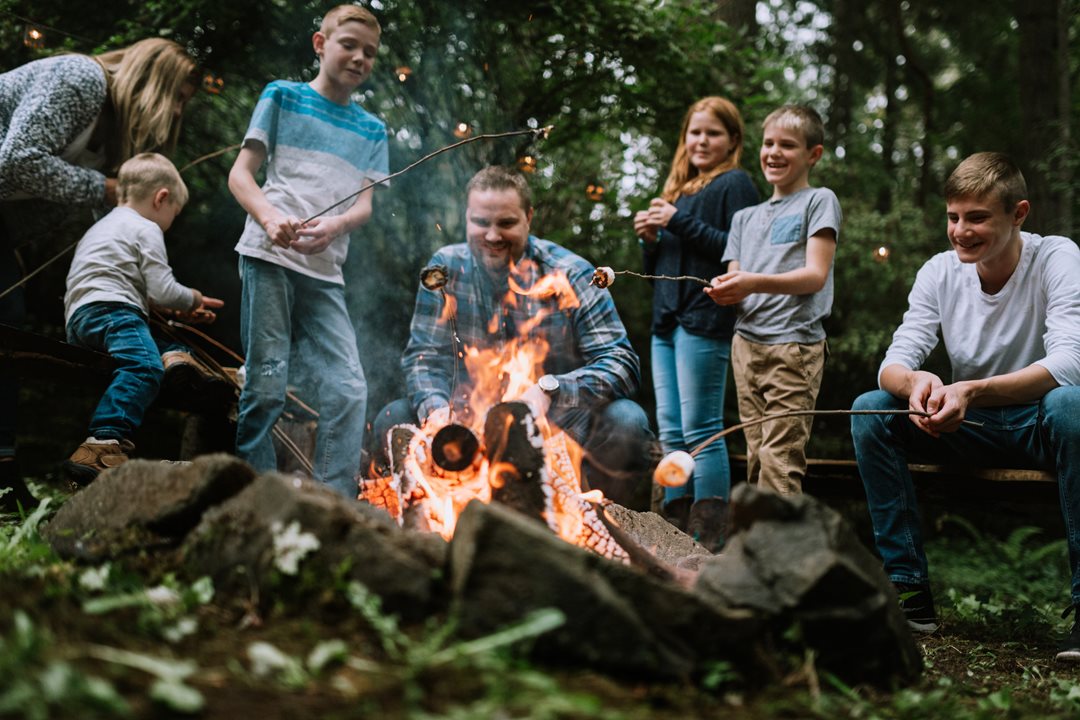Wildfire prevention: Campfire safety | PEMCO
 Few experiences say “PNW” like sitting around a crackling campfire. But safely making memories over an open flame requires more than just torching wood in a firepit. Every year, out-of-control campfires spark wildfires and lead to burn injuries.
Few experiences say “PNW” like sitting around a crackling campfire. But safely making memories over an open flame requires more than just torching wood in a firepit. Every year, out-of-control campfires spark wildfires and lead to burn injuries.
For the love of prevention, here’s what to know before you toast those marshmallows or share creepy stories arond the campfire.
How to build, tend, and safely extinguish your campfire
While campfires gone wrong don’t top the list of wildfire causes, backcountry fires are among the toughest to fight since they’re often miles from tanker-friendly roads and accessible water sources.
If your summer plans include a camping trip or even a backyard fire pit, check out these 10 tips to prevent a fun, innocent fire from turning into an accident:
-
Know when and where it’s OK to burn. Shifting fire conditions at your destination may lead to restrictions including no campfires, use of approved lanterns and stoves only, or even closures of trails or entire campgrounds. It’s best to know before you go!
In Washington, see the Department of Natural Resources for burn-ban information. In Oregon, contact the Oregon Department of Forestry office in the area you plan to visit. Check the Environmental Protection Agency for burn bans affecting tribal lands in Washington, Oregon, and Idaho. For federal lands, see searchable sites from the U.S. Forest Service and National Park Service. Another good bet: Check with local fire districts for last-minute changes.
-
Select the right site for your campfire. If your campsite already has a fire ring (with either metal or stone sides), use it. If not, look for a level spot that’s at least 15 feet from anything, even a tent, that can burn. Avoid areas with low-hanging branches or shrubs and clear an eight- to 10-foot radius down to bare soil (no dry twigs, leaves, or needles) around the fire ring to tame errant sparks. Try to pick a spot that’s protected from wind gusts.
-
Dig a pit or consider a firepan if there’s no fire ring. Use a camp shovel to dig a pit about a foot deep in the earth and circle it with rocks. Or, if digging’s not your thing, invest in a metal firepan to contain your fire. You can find collapsible models at outdoor retailers, or you can improvise one by flipping over a sturdy metal garbage can lid or using the base of an old barbecue. Ideally, it will have three-inch sides to contain the fire and can be placed on rocks to avoid scorching the ground underneath.
-
Keep containers of water and a shovel nearby. Before you light your fire, make sure you already have a way to put it out in case things go sideways.
-
Collect the right fuel. You’ll want three types of fuel for your safe campfire – tinder like dry grass, leaves, and needles; kindling like small dry twigs; and firewood that’s sourced locally. Firewood packed in from outside the area allows invasive insect species to hitch a ride to new locations. If you’re gathering firewood onsite, use only dry, dead wood, no thicker than your wrist. Don’t cut standing trees or break off branches even if they’re dead, since dead trees provide wildlife habitat.
-
Build your fire. Loosely pile tinder in the center of your fire pit. Over that, lay kindling twigs in a tent shape or crisscross them. Light the tinder and discard the match into the fire. Don’t use accelerants, but you can blow lightly at the base of the fire to help it take off. Add more kindling, then carefully place firewood a few pieces at a time. When it comes to campfires, bigger isn’t better! A fire no bigger than two feet across is best. Remember, if it’s so big or hot that you can’t get close enough to toast a marshmallow, it’s too big!
-
Don’t burn dangerous trash. Avoid the temptation to toss in aerosol cans, plastic, glass containers, or cans that could explode or won’t burn completely.
-
Keep an eye on kids. Fire fascinates kids and, sadly, they’re most often the people injured by getting too close or poking too enthusiastically at the fire. Never leave your fire unattended.
-
Extinguish your fire completely. Burn wood until it reaches the white ash stage, then cook up, as Leave No Trace calls it, a batch of “campfire soup.” Drown it with water until the sizzle stops, stir it up, and check the heat with your hand. If you don’t have enough water, smother the ashes with dirt or sand. Scrape and stir with your shovel to ensure all embers are out, then add more dirt or sand. If it’s too hot to touch, it’s too hot to leave.
-
Consider a non-campfire. Yes, you really can have fun without the smoke and crackle! Rely on lanterns for light and propane camp stoves for cooking. The advantage? Without the brightness of the fire, you’ll be able to see the beauty of the stars more clearly.
We’re all in on prevention because we’re all in on you
Get ready for a wildfire-safe summer with our curated collection of wildfire resources on pemco.com. Also, watch for articles and social content to help you make the most of your PNW adventures ahead.
Share on social media